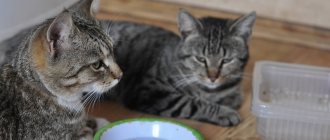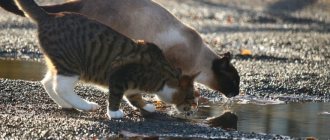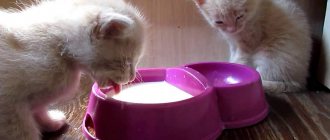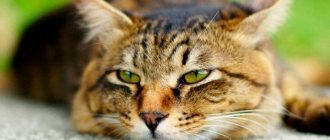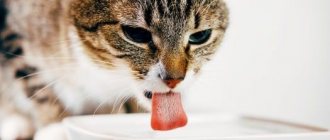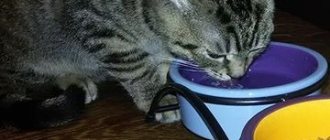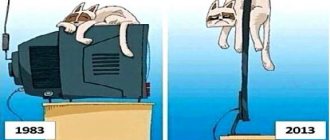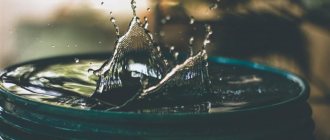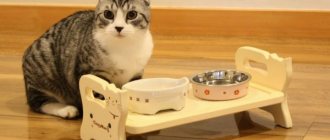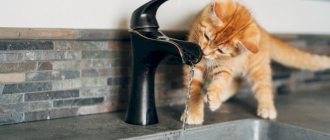As soon as the long-awaited kitten is at home, the owner has many problems and questions. In addition to the eternal ones - what to feed and where will he go to the toilet, another one arises: why doesn’t the kitten drink water, but at the same time eats well? In our article we will try to figure out in which cases this issue may cause concern and in which it does not.
What are the dangers of a lack of fluid in a cat?
The situation when a kitten does not drink water causes great concern for the owner and for good reason. If the baby does not drink, then this is very dangerous for his health, as it can cause the development of urolithiasis. A condition during which a cat drinks little can lead to the death of the pet. From a lack of moisture, his general health deteriorates, which immediately affects the condition of the coat and whiskers.
When a cat does not drink water, it is dangerous because the lymph thickens, a disturbance in water-salt metabolism occurs, which leads to serious consequences.
There is a danger when a cat drinks little water and at the same time eats dry food that contains little liquid, so the pet must drink more, otherwise dehydration can cause growth retardation, which will lead to serious health problems. In this situation, it is necessary to force the pet to drink water, we will tell you how to do this below.
What cases should not cause concern to the owner?
If the pet is very small and is fed by the mother cat's breast milk, then there is no need to worry that the kitten does not drink water, because it draws all the necessary liquid from the mother's milk. At this time, the baby, in addition to all the necessary nutrients, also receives the right amount of moisture.
There is also no need to worry that the cat does not drink water when it eats natural food; products such as kefir, milk, sour cream, and eggs contain the necessary liquid. When a cat eats canned food or cereal, it requires less moisture than when it eats dry food.
What to do and how to train it?
In the case when the pet does not want to drink water on its own, you can teach it using a syringe.
If a kitten does not drink water, then perhaps he simply does not know how to do this and then the owner teaches him on his own. It is recommended to keep your pet busy with games that will cause a feeling of thirst. If after this the animal refuses to take liquid, then you can first teach the kitten to drink water from a syringe. It is worth placing the drinking bowl at a distance from the food container so that the former remains clean. It is possible to teach how to drink water in other ways:
- Place several bowls of water in different areas of the room where the cat lives. There is a high probability that he will like at least one place. If the kitten starts drinking from one container, then all other containers are removed, leaving the one chosen by the animal.
- They offer to drink from bowls of different colors, shapes and sizes. Pets can be picky, so if they don't like the dishes, they can easily refuse to drink water.
Veterinarians advise that if a cat does not know how to drink, then during training it is worth offering him water of different temperatures, since some pets prefer cold water, while others choose warmer water.
Why does a cat not drink?
The main reasons why a kitten does not drink liquid:
- The baby, who has just been separated from his mother cat, does not yet know how to drink water; he is not accustomed to it. When you bring a baby into the house, you need to gradually teach him to drink from a saucer. It would not be bad for a kitten to come into the house taught to drink water from its mother cat.
- When a cat's drinking area is dirty, it will not drink the water. Cats are fairly clean creatures, so they won't use a dirty bowl. It is for this reason that a cat drinks from a tap or from an aquarium.
- Sometimes dishes intended for drinking are made of poor quality raw materials, they have a strong odor or color, and cats are very sensitive to foreign odors. A ceramic bowl is best suited for water for a cat; it is made from natural raw materials, has no odor, and is easy to clean.
- When a cat does not drink from a bowl, this may be the reason that he is simply not accustomed to this procedure. He's trying to get a drink from somewhere else. In this case, you need to observe where it is more pleasant for him to drink and try to provide similar utensils as a replacement.
- The kitten may be put off by the smell of chlorine present in the water. You can buy him bottled water or filter your own.
- Another reason is the pet’s illness. If he does not drink liquid, this may be a signal that the cat is ill. For a more accurate diagnosis, you need to pay attention to symptoms such as diarrhea, vomiting, weakness, and apathy. In this case, you need to contact a veterinarian so that he can make a diagnosis and suggest how to force the cat to consume more moisture.
British fold blue whiskey color
I never tire of admiring the richness and flexibility of the Russian language, in which new verbal formations periodically arise, completely crazy in essence, but absolutely understandable in meaning to most people. Cats have not been left out either, and a striking example of this is the stable phrases British fold cat, British blue kitten and Whiskas cat. So who are they?
British fold
In fact, there are two separate breeds - the British Shorthair and the Scottish Fold. Unlike the British breed, the Scottish Fold appeared much later and the specifics of its breeding are such that a partner with a normal ear shape must be selected to pair with the Fold. Initially, the breed arose from the British, and although several breeds took part in the formation of the modern appearance of the Scottish Fold, in Russia matings with the British were widespread, especially until 2004, when in the most extensive felinological system of the WCF, all straight-eared kittens from such marriages were registered as British people with BRI coding, although their genetics were different. This is difficult to understand for a person inexperienced in matters of breeding, especially considering that due to the numerous connections of the British breed to the Scottish Folds, many animals of an intermediate type and straights and folds of the British type appeared. That is why this strange phrase arose as “British Fold” in conjunction with the British Straight Ear, apparently, since in appearance they were practically no different, only in the shape of the ears. (The photo on the right shows littermate kittens born in 1997, registered as Scottish Fold and British).
| Schematic representation of a typical British and typical Scottish Fold head |
| When comparing, it is clearly visible that the British have fuller cheeks; the shape of the fold's ear pads for the British would be pinched. In profile, you can see that the Fold has a round head set higher on the neck, while the British has a rounded head set low on the neck, which creates the impression of a powerful scruff. The fold profile for a Briton would be too extreme; according to the standard, the transition from forehead to nose is smooth, outlined but without a stop (sharp transition). The Scottish Straight has higher and straighter ears, with the auricle facing forward. |
| Comparison of the British and Scottish Fold physiques |
| The Briton has a large heavy body, on short powerful limbs, a short thick tail, rounded at the end. In height from the withers to the floor, the body occupies 2/3 and the legs 1/3. The Scottish Fold has a lighter constitution, longer limbs and a long, tapering tail. In height from the withers to the floor, the body and legs occupy 1/2 each. |
British blue
Another essentially incorrect phrase. Yes, the blue color is the most common and recognizable in the British breed, at least among ordinary people, but it also recognizes all colors existing in nature, and the breed is called the British Shorthair, not the British Blue. In contrast to the “Russian Blue” breed, which really exists in a single color variation, blue, which is included in the name of the breed.
|
|
Whiskas color or whiskey color
There is no such color! No whiskey, no whiskey. Whiskas is a company that produces products and food for cats, which has chosen British cats of the silver-black patterned color group as advertising for its products. And these are at least three different colors - spotted, brindle and marbled. In the photo on the left, the kittens are not “whiskey”, but black silver spotted (BRI ns 24) and black silver marbled (BRI ns 22) colors!
How can you train a cat to drink water?
To avoid health problems in the future, he must be taught to drink more from an early age. How to do this? The easiest way is to teach a cat to drink water after an active pastime. During play, the kitten loses more moisture than in a calm state. This is a great chance to teach them to drink clean, cool water from a bowl.
When a kitten categorically does not drink, you can try to force him to drink, for example, using a syringe filled with water. You can also add extra liquid to the food your cat eats if it contains little water.
There is no need to place bowls of water next to the food that the cat eats, because the liquid must only be perfectly clean, otherwise it will be impossible to accustom the pet to drinking moisture.
The selection method has proven itself quite well; to do this, you need to place bowls of clean water throughout the house, in this way you can find out exactly where the cat is most comfortable drinking moisture and what level is most convenient for him. You can try pouring it into bowls of different shapes and sizes. As a rule, pets most like bowls that resemble a lake, that is, the larger the volume, the more comfortable it is to use.
You can dilute canned food in water, this can help accustom him to water, but dry food cannot be diluted, because this can lead to improper water quality.
Another aspect is the need to understand what kind of water a cat drinks more and better. Some animals prefer cold water, some prefer room temperature, and there are cases when cats drink warm water better. When an animal prefers a flowing one, then you should think about purchasing a drinking bowl in the form of a fountain or leaving the tap slightly open. This will provide the opportunity to consume moisture at any time.
Reasons why a kitten does not eat dry food
You need to understand what foods your pet likes. Perhaps he prefers to eat liquid cat food or natural products. In this case, it is worth thinking about the need to feed the animal and accustom it to dry food.
It is convenient to feed him prepared food, as this saves the owner’s time. In addition, cat food manufacturers claim that the food contains essential nutrients and vitamins.
In order to teach your pet to eat dry food, you need to understand the reason why your pet refuses it:
- The cat may not like the food or may simply be too cold.
- Dry food can become boring for an animal. In such a situation, it is worth switching to canned cat food so that the diet is varied.
- The food lost its attractive smell for the kitten after the food had been left in the air for several days. It can be removed after he has eaten. At your next meal you need to add a fresh portion of food.
- Your pet may refuse to eat from dirty dishes that contain dried food remains.
- Water got into the bowl; soaked food is disgusting to cats.
- If the kitten is lethargic, does not go to the toilet, and refuses any food or water, then this may indicate that the pet is sick.
- Perhaps he is full and does not want to eat.
What kind of water is best to give to a cat?
When a cat drinks a lot, it’s good, so what kind of water should it be for your pet to like it:
- Firstly, it must be clean.
- Do not contain foreign odors.
- Must be in the public domain for the pet.
- Change often.
- Before giving tap water, it must first be settled or filtered.
Some owners want to accustom them to tap water, but they should not do this, because such water contains chlorine, it is hard and of little benefit to the kitten.
Some owners, in order to force the animal to drink more liquid, add a little fish soup to it to add a smell.
Which water is best for a kitten?
The health of a kitten depends not only on the amount of water, but also on its quality. Before you worry about the amount of liquid you need to drink, you need to take care of which water is best for your kitten.
Types of liquid:
- Boiled;
- Distilled;
- Raw;
- Tap;
- Bottled.
Boiled water has very few nutrients. Scientists call such a liquid dead, and after three hours after boiling it becomes harmful due to the attraction of bacteria and viruses that are in the environment. Veterinarians do not advise giving your kitten boiled water not only for this reason, it can lead to the development of urolithiasis.
Distilled water is practically useless.
Tap water is endowed with many chloride compounds, various bacteria, organisms, salts and metals.
The entire composition of fresh tap water is absolutely unnecessary for a cat’s body, especially a small one.
Raw water from a spring or well is useful, but at the same time it can contain a large amount of unnecessary substances, including nitrates, iron and salts.
The best option is bottled water, but it must be of high quality. It is better to give the kitten water from a bottle, which is obtained from underground sources, of the highest category. Such water is usually not cheap and not every person buys it.
In order not to complicate your life with trips to the store and a difficult search for water of the highest category, you can give your kitten regular tap water. Before pouring it into saucers, it is worth settling or filtering the water.
How to determine if your cat drinks enough fluid per day
To make sure that your cat drinks a lot and has enough moisture entering the body, you need to pay attention to:
- Condition of the skin. When your pet drinks little fluid, the skin becomes inelastic. Only in a well-drinking pet will the scruff of the neck return when pulled back. When this does not happen, then we can confidently say that the cat is not receiving enough fluid.
- Only an animal that drinks well has shiny fur.
- When an animal eats dry food and drinks little water, it becomes lethargic and lacks physical activity.
- You need to pay attention to how often the cat urinates; if it urinates at least 2-3 times a day, then this is a sign of normality. This can be easily checked by the condition of the tray.
The normal functioning of organs depends on how much moisture enters the pet’s body. To prevent the kitten from becoming lethargic, it needs a large amount of fluid.
Methods for determining the amount of water you drink per day
Cats drink as much as they need. According to statistics, the daily norm should be from 20 to 40 mg per 1 kg of body. If your cat weighs 5 kg, she should drink up to 100 ml of liquid per day. Pregnant and breastfeeding women should drink twice as much. Breastfed kittens do not need water at all. They receive their daily fluid intake from their mother's milk.
A cat's body is made up of 70% liquid.
The given amount should not be considered as something that a pet must necessarily drink daily. Consumption depends on the following points:
- age, weight and breed of the cat;
- time of year and room temperature;
- type of feed;
- convenience of drinking bowl.
If the cat is on dry food, liquid intake should be two or three times the amount eaten. For example, if an animal eats 50 g of food, then it should drink from 140 to 180 g of water, depending on its weight. Canned food contains about 80% liquid. To quench your thirst, 100 g of water will be enough for your cat.
Important! Even if the kitten has eaten soup or drank kefir, clean water must be present, otherwise it will not receive the necessary minerals. Increased thirst over several days is a reason to consult a veterinarian
Increased thirst over several days is a reason to consult a veterinarian
The less a cat drinks fluids, the less elastic its skin
Step-by-step instruction:
Carefully grab the skin above the shoulder blades. Pull it up and down. Normally, it should immediately return to its place.
Kittens under eight months of age have rougher skin than older cats and will take longer to recover.
You also need to pay attention to how often your cat urinates. If she goes to the litter box at least 2-3 times a day, then this is a sign of normality.
This can be easily checked by the condition of the tray.
You can do one of the old tests: open your pet's mouth slightly and lightly press on the gums. If it acquires a light shade and does not change color within three seconds, this indicates illness.
Important! If the mucous membrane is light, saliva is viscous and weakly secreted, this may indicate pathology. You can check for dehydration by looking at your eyes.
Deeply sunken ones indicate that the cat is not drinking enough fluids. In a healthy animal, the eyes appear slightly sunken. With age, as well as in thin or chronically ill pets, sunken eyes indicate normal
You can check for dehydration by looking at your eyes. Deeply sunken ones indicate that the cat is not drinking enough fluids. In a healthy animal, the eyes appear slightly sunken. With age, or in thin or chronically ill pets, sunken eyes are normal.
Note! Cold paws indicate severe dehydration. The main symptoms also include:
The main symptoms also include:
- dry skin;
- lethargy;
- apathy;
- poor appetite;
- sunken eyes;
- constipation or diarrhea;
- arrhythmia;
- poor sleep;
- weight loss;
- saliva viscosity;
- pale gums.
Important! If at least one sign is detected, it is necessary to immediately begin procedures to restore water balance. Cats' fluid intake varies from person to person.
It depends on several factors:
Cats' fluid intake varies from person to person. It depends on several factors:
- Animal weight. For every kilogram of body weight of a four-legged pet, ideally there should be from 20 to 40 ml of water per day, according to other sources - about 50 ml.
- Age. Kittens require less fluid than their mature counterparts. Most older cats are thirsty.
- Nutrition. A pet that eats high-quality ready-made food that does not contain salt and has a balanced composition needs less water than its counterpart that eats a low-quality product. Broths and gravies included in a cat's diet, which consists of natural food, provide their body with moisture, as a result of which the pet's need for clean water is reduced.
- Level of physical activity. Energetic cats require more fluids than four-legged couch potatoes.
- Time of year and air temperature in the room where the pet is constantly located. In the heat, the need to drink increases.
How can this problem be solved?
First we need to discuss water quality. Cats will always prefer fresh, clean water to stagnant or cloudy water. Therefore, the water should be changed daily or even several times a day - it will only be better.
We must not forget that the water in the bowl can become contaminated not only from dust or the ingress of some foreign objects, but also from cat saliva, which gets there in sufficient quantities after the first drink.
If a dog lives in the house with a cat, then it will probably drink from the same bowl, which can also affect the cat’s attitude towards such water. In this case, you should block the dog's access to the cat's drinking bowl. For example, a bowl can be placed on a windowsill.
One of the unsuccessful options for a water container is a double bowl into which both food and water are poured. In bowls with a similar device, food particles often fall into the water, contaminating it. The same thing happens when the water bowl is too close to the food bowl. Also, you should not use the same bowl for eating and drinking; in other words, the drinking bowl must be a separate container.
Care should be taken to ensure that the water does not contain any impurities and does not have any repulsive odors. Perhaps you should refrain from using various detergents and cleaning products, since they leave odors that the cat will not necessarily like. Although it can be argued that she will not like them for sure.
When is there no reason to worry?
A very small kitten has not yet transitioned to an adult lifestyle, and therefore receives all the necessary substances from the milk of its mother cat. Milk is both food and drink for the baby, so very young animals should not be persistently given water.
There is also no reason to worry if the animal eats a lot of natural food containing moisture. Such suitable foods include dairy products, eggs, buckwheat and other cereals. If your pet eats canned food, then it can also get enough water from it.
Advice for people who want to quit drinking
Not every person who has previously abused alcoholic beverages finds it easy to maintain a sober state. Some people experience a painful craving for alcohol, a desire to immediately have a drink or two. For those who have firmly and confidently taken a sober path, such advice can help.
- You should contact a specialized clinic. Here, specialists will select an individual treatment plan and, if necessary, prescribe effective drug treatment. Psychologists and rehabilitation specialists will help you get out of binge drinking, cleanse your body, and develop a persistent negative attitude toward drinking ethanol.
- If you want to quit drinking, that's half the battle. The patient should recognize the presence of the disease. If possible, the problem with alcohol should be discussed with loved ones.
- The patient should cut off all ties with people with whom he drank and who were tolerant of his addiction.
- At home, you need to throw away all alcoholic drinks. This will make it much easier to avoid temptation. If there is a calm reaction to people drinking alcohol, this is already a success.
- You need to be prepared for the fact that withdrawal symptoms will develop while giving up alcohol. At the same time, various psychophysiological disorders will be tormented. The urge to remove them can be very strong. At this time, it is important not to give in to weakness. It is very difficult to combat the symptoms of withdrawal on your own, so you should trust the specialists.
- You should read literature on various aspects of alcoholism. It is important to avoid sources of dubious origin. Any questions can be discussed with your doctor.
- Your daily routine should include different types of physical activity. It is important to eat quality and nutritious food, as well as rest. It is ideal to learn to avoid stress or at least not react to it.
- For some, moving and being with other people can help.
- An interesting hobby will help improve your emotional background. Some people find it helpful to change careers, volunteer and be active.
- At meetings and holidays, you need to look for an alternative to alcoholic drinks, which, unfortunately, have become traditional. Even one cocktail can derail all previous efforts.
There is no universal method for stopping drinking. Every alcohol dependent person should look for the most suitable option. To avoid relapses and achieve a positive effect, it is important to contact specialists.
Norm per day
In the body of an animal, including a cat, water makes up 4/5 of its body. The overall functioning of all functions and organs depends on the amount of fluid; a lack of water leads to a slowdown in the absorption of necessary substances into each cell.
If the kitten completely stops drinking liquids or eating wet food, the plasma and lymph will become thick, the water-salt metabolism will change, which will lead to frightening consequences. With age, there is less and less water in the body. In the body of a young pet, moisture is somewhere around 70-80%, in an old cat - 50%.
The internal reserves of a young cat are enormous, and even if he stops drinking water, and this lasts for a week, he will be able to survive. With older pets the situation is different.
Doctors believe that the amount of fluid that a cat must necessarily drink can be calculated. It all depends on the weight of the animal. The norm is calculated using the standard formula: weight * per 0.03.
We must not forget that drinking a large amount of liquid to an animal is much more dangerous than refusing it. If a cat drinks a lot of water, then his kidneys are in danger or he has been poisoned.
The cat doesn't drink water.
#1 Omi
- Participants+
- 6 messages
- Administrators
- 15,540 messages
- Regular visitors
- 2,255 messages
#2 Felina
Is the food wet or dry? Cats can get enough water from wet water so that they don't have to drink too much later.
#3 Sestratk
Cat Soul Healer
A cat that does not drink water should absolutely not be fed dry food. How to train it - here is the article: A cat can live much shorter without water than without food. A cat can “save” water by highly concentrating its urine, which can lead to the formation of stones in the urinary tract. Therefore, it is very important that your cat gets enough water.
In temperate climates, a cat should drink 40-60 ml of water per kilogram of weight daily. The main losses of fluid from the body occur in saliva, feces and urine. The worse the food is digested, the greater the loss of water in feces.
A cat gets water from two sources: from drinking and food. Wet food and natural food contain up to 80% liquid, so cats on this type of feeding usually drink little. If a cat eats super-premium quality dry food, then it must drink two, or better yet, three times more water than the food it eats. This is a necessary condition for food to be used for good and not harm.
What to do if your cat drinks little? You can supplement it with water every day from a syringe without a needle into the corner of your mouth. But you can try to follow some recommendations.
— The “food” area should be as far as possible from the “toilet” area.
— Bowls for water and food should be kept at a distance from each other.
— It is better to use bowls made of stainless steel, earthenware or polypropylene.
Place water containers of different shapes and sizes in different places and watch your cat. Our little individualists often surprise us: some are served almost in a basin on the floor, some agree to drink only from a mug, others prefer tap water.
Instead of tap water, you can offer your cat a drinking fountain. A bright bowl with an anti-slip coating can also attract your cat's attention. You can try to lure the cat to the bowl with a game: pour water from one container to another, put bright toys or pieces of treats into the water: in all available ways, strengthen the connection between water and pleasant associations. Try it - it works!
At one time, I spent quite a lot of effort trying to teach a very light-drinking cat to drink the required amount of water. My cat drank so little that she even became dehydrated and I had to supplement her with a syringe.
How I taught my cat to drink
My first purebred cat came to live with me when she was 4.5 months old. She quickly adapted and everything was fine, only my cat didn’t drink enough. I’ll put her next to a bowl of water, she’ll lick the water a few times, and that’s it. I thought that nature cannot be fooled and a cat cannot die from lack of water next to a full bowl. I was wrong.
When she got sick, I saw for the first time that she was quite capable of actively lapping up water. But, after recovery, the cat stopped drinking again. At best, she was playing with water.
At first I cooked her cat “soup”, when we switched to drying, I soaked the dry food with the prescribed amount of water (15 g of water per 5 g of drying). And she also fed it from a syringe. But I was haunted by the thought that she knew how to drink, but didn’t drink. And few people would agree to give a cat that doesn’t drink extra food on purpose if I suddenly have to leave. A cat cannot live without water! And I decided that the situation urgently needed to be corrected. Moreover, the cat is young and you can try to teach her to drink on her own.
Experienced people advised to try different dishes for water. In my kitchen there are several bowls of different sizes, a plate, and a jug. I poured water from the jug into the bowl and back, played with her pussy, wet her nose - she was happy to communicate, happily played with the surface of the water, even bit it, but did not drink! We continued to drink from a syringe. And then I thought: why would my cat drink on her own if she already has enough water? I soak the food and feed her some more!
The most important stage has begun. I stopped soaking the food. After giving her pussy a drink at night, she poured some “crackers” on it in the morning. But the bowl of water still did not arouse her enthusiasm. But the kitty began to greet the syringe with water with joy: she reached out to it with her muzzle, made lapping movements with her tongue, and opened her mouth herself. It became very easy to finish drinking it! This is what I decided to take advantage of. First I tried pouring water into a bowl from a jug. Kitty began to bite the stream and began to try to drink. But a trickle from a jug is also not very convenient, and we are terribly afraid of the tap! Then I decided to take advantage of her trust in the syringe.
Seeing a syringe with water, the pussy joyfully ran towards it. I showed her that there was water in the syringe: I splashed or scooped water from the syringe into a bowl of water. I squeezed a drop of water onto her nose and she licked her lips. The syringe was brought closer to the bowl of water, a stream was released from it, which the kitty caught with her tongue. And then I put the syringe in a bowl with the tip on the side. And it worked! My girl tried to get the syringe out with her paw, but she couldn’t, and it was wet. How to catch it with your mouth? - He's in the water. Lick the water, lick it - that's what you need. And I’m nearby, petting her and praising her.
